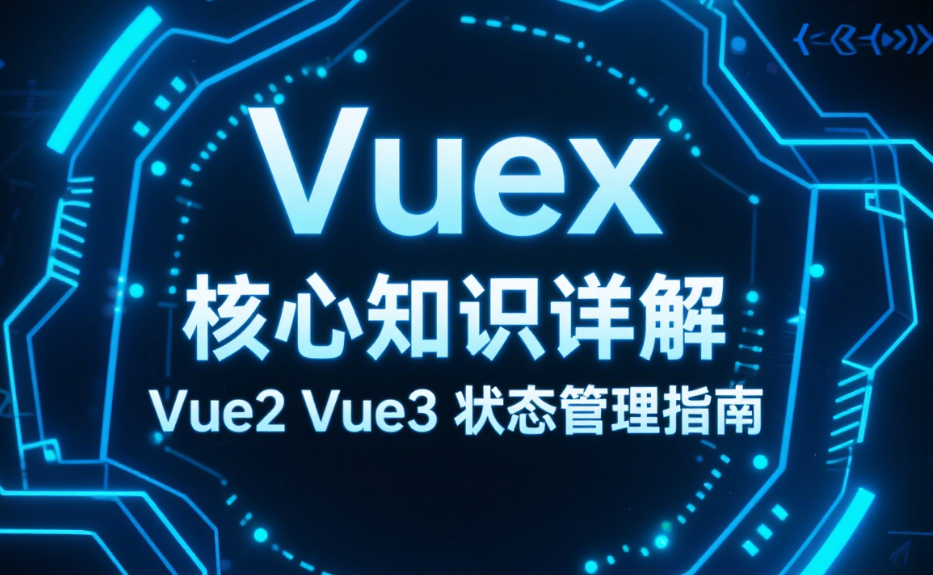Vuex 核心知识详解:Vue2Vue3 状态管理指南
文章目录
- Vuex 核心知识详解:Vue2/Vue3 状态管理指南
- 引言:为什么需要 Vuex?
- Vuex 的核心概念
- 1. State:单一状态树
- 2. Getters:计算属性
- 3. Mutations:同步修改状态
- 4. Actions:异步操作
- 5. Modules:模块化
- Vuex 核心概念对比表
- Vue2 和 Vue3 中使用 Vuex 的区别
- Vue2 中使用 Vuex
- Vue3 中使用 Vuex
- 最佳实践
- 常见问题解答
- 总结

Vuex 核心知识详解:Vue2/Vue3 状态管理指南
引言:为什么需要 Vuex?
想象一下你正在开发一个大型 Vue 应用,组件树越来越复杂,组件之间需要共享和修改数据的情况越来越多。这时候,如果仅靠组件间的 props 和事件通信,代码会变得难以维护,就像这样:
组件A → 组件B → 组件C → 组件D → 组件E
(想从A传递数据到E,需要经过B、C、D层层传递)
Vuex 就是为解决这类问题而生的!它是 Vue 的官方状态管理库,提供了一个集中式存储管理应用的所有组件的状态(数据),并以相应的规则保证状态以一种可预测的方式发生变化。
Vuex 的核心概念
Vuex 的核心架构可以用以下流程图表示:
┌─────────────┐ ┌─────────────┐ ┌─────────────┐
│ 组件调用 │ │ 提交 │ │ 派发 │
│ State │──────▶ │ Mutation │──────▶│ Action │
└─────────────┘ └─────────────┘ └─────────────┘▲ │ ││ │ │└─────────────────────-┼──────────────────────┘▼┌─────────────┐│ Getter │└─────────────┘
1. State:单一状态树
State 是 Vuex 的核心,存储所有共享数据,类似于组件中的 data。
// store.js
import Vue from 'vue'
import Vuex from 'vuex'Vue.use(Vuex)const store = new Vuex.Store({state: {count: 0,user: {name: '张三',age: 25},todos: [{ id: 1, text: '学习Vuex', done: true },{ id: 2, text: '写项目', done: false }]}
})
在组件中使用 state:
// 组件中访问state
export default {computed: {count() {return this.$store.state.count // 直接访问},// 使用mapState辅助函数...Vuex.mapState(['user', 'todos'])}
}
2. Getters:计算属性
Getters 类似于组件中的 computed,用于对 state 进行派生计算。
const store = new Vuex.Store({state: {todos: [{ id: 1, text: '学习Vuex', done: true },{ id: 2, text: '写项目', done: false }]},getters: {// 获取已完成的任务doneTodos: state => {return state.todos.filter(todo => todo.done)},// 获取特定id的任务getTodoById: (state) => (id) => {return state.todos.find(todo => todo.id === id)}}
})
在组件中使用 getters:
export default {computed: {// 直接访问doneTodos() {return this.$store.getters.doneTodos},// 使用mapGetters辅助函数...Vuex.mapGetters(['doneTodos', 'getTodoById'])},methods: {findTodo() {const todo = this.getTodoById(1) // 使用带参数的getterconsole.log(todo)}}
}
3. Mutations:同步修改状态
Mutations 是修改 state 的唯一途径,必须是同步函数。
const store = new Vuex.Store({state: {count: 0},mutations: {// 基本mutationincrement(state) {state.count++},// 带参数的mutationincrementBy(state, payload) {state.count += payload.amount},// 使用常量作为mutation类型[SOME_MUTATION](state) {// 执行某些操作}}
})
在组件中提交 mutation:
export default {methods: {increment() {// 直接提交this.$store.commit('increment')// 提交带参数的mutationthis.$store.commit('incrementBy', { amount: 10 })// 对象风格提交this.$store.commit({type: 'incrementBy',amount: 10})},// 使用mapMutations辅助函数...Vuex.mapMutations(['increment', 'incrementBy'])}
}
4. Actions:异步操作
Actions 类似于 mutations,但是用来处理异步操作,在组件中调用可以 传参给vuex ,最终通过提交 mutation 来修改 state。
const store = new Vuex.Store({state: {count: 0},mutations: {increment(state) {state.count++}},actions: {// 基本actionincrementAsync({ commit }) {setTimeout(() => {commit('increment')}, 1000)},// 带参数的actionincrementByAsync({ commit }, payload) {return new Promise((resolve) => {setTimeout(() => {commit('incrementBy', payload)resolve()}, 1000)})},// 组合多个actionactionA({ commit }) {return new Promise((resolve) => {setTimeout(() => {commit('someMutation')resolve()}, 1000)})},async actionB({ dispatch, commit }) {await dispatch('actionA') // 等待actionA完成commit('anotherMutation')}}
})
在组件中分发 action:
export default {methods: {increment() {// 直接分发this.$store.dispatch('incrementAsync')// 分发带参数的actionthis.$store.dispatch('incrementByAsync', { amount: 10 })// 对象风格分发this.$store.dispatch({type: 'incrementByAsync',amount: 10})},// 使用mapActions辅助函数...Vuex.mapActions(['incrementAsync', 'incrementByAsync'])}
}
5. Modules:模块化
当应用变得复杂时,可以将 store 分割成模块(module),每个模块拥有自己的 state、mutations、actions、getters。
const moduleA = {state: () => ({count: 0}),mutations: {increment(state) {state.count++}},getters: {doubleCount(state) {return state.count * 2}}
}const moduleB = {state: () => ({message: 'Hello'}),actions: {showMessage({ state }) {console.log(state.message)}}
}const store = new Vuex.Store({modules: {a: moduleA,b: moduleB}
})
在组件中使用模块:
export default {computed: {count() {return this.$store.state.a.count // 访问模块a的state},doubleCount() {return this.$store.getters['a/doubleCount'] // 访问模块a的getter}},methods: {increment() {this.$store.commit('a/increment') // 提交模块a的mutation},showMessage() {this.$store.dispatch('b/showMessage') // 分发模块b的action}}
}
Vuex 核心概念对比表
| 概念 | 作用 | 特点 | 示例 |
|---|---|---|---|
| State | 存储应用状态数据 | 响应式,唯一数据源 | state: { count: 0 } |
| Getters | 从state派生状态,类似计算属性 | 可缓存,可组合 | doneTodos: state => state.todos.filter(t => t.done) |
| Mutations | 修改state的唯一途径 | 必须是同步函数 | increment(state) { state.count++ } |
| Actions | 处理异步操作,提交mutation | 可以包含任意异步操作 | incrementAsync({commit}) { setTimeout(() => commit('increment')) } |
| Modules | 将store分割成模块 | 每个模块拥有自己的state、getters、mutations、actions | modules: { user: userModule } |
Vue2 和 Vue3 中使用 Vuex 的区别
Vue2 中使用 Vuex
// main.js
import Vue from 'vue'
import Vuex from 'vuex'
import App from './App.vue'Vue.use(Vuex)const store = new Vuex.Store({// ...store配置
})new Vue({store,render: h => h(App)
}).$mount('#app')
Vue3 中使用 Vuex
Vue3 中虽然可以使用 Vuex,但官方推荐使用 Pinia(下一代的 Vue 状态管理库)。不过仍然可以这样使用 Vuex:
// main.js
import { createApp } from 'vue'
import { createStore } from 'vuex'
import App from './App.vue'const store = createStore({// ...store配置
})const app = createApp(App)
app.use(store)
app.mount('#app')
最佳实践
- 遵循单向数据流:组件 → 派发 Action → 提交 Mutation → 修改 State → 更新组件
- 模块化组织:大型应用按功能划分模块
- 使用常量替代 Mutation 事件类型:便于维护和协作
- 严格模式:开发环境下开启严格模式避免直接修改 state
const store = new Vuex.Store({strict: process.env.NODE_ENV !== 'production' }) - 表单处理:对于 v-model 绑定的 Vuex state,使用计算属性的 getter 和 setter
computed: {message: {get() {return this.$store.state.message},set(value) {this.$store.commit('updateMessage', value)}} }
常见问题解答
Q: 什么时候该用 Vuex?
A: 当你的应用遇到以下情况时:
- 多个组件依赖于同一状态
- 来自不同组件的行为需要变更同一状态
- 组件层级很深,需要多层传递 props 和事件
Q: 可以直接修改 state 吗?
A: 严格模式下不允许!必须通过提交 mutation 来修改 state,这样才能被 devtools 追踪。
Q: Action 和 Mutation 有什么区别?
A:
- Mutation: 同步事务,直接修改 state
- Action: 可以包含异步操作,通过提交 mutation 来修改 state
Q: Vuex 和 localStorage 有什么区别?
A:
- Vuex 是内存存储,刷新页面会丢失
- localStorage 是持久化存储,但不会自动响应式更新组件
- 通常可以结合使用:Vuex 存储运行时状态,localStorage 持久化重要数据
总结
Vuex 作为 Vue 的官方状态管理库,通过集中式存储管理应用的所有组件的状态,并确保状态变更的可预测性。核心概念包括:
- State - 数据仓库
- Getters - 计算派生数据
- Mutations - 同步修改状态
- Actions - 处理异步操作
- Modules - 模块化组织
记住这个简单的流程:组件 → Action → Mutation → State → 组件,你就能掌握 Vuex 的精髓了!
希望这篇详细的指南能帮助你更好地理解和使用 Vuex。随着应用的复杂度增加,良好的状态管理将大大提高代码的可维护性和开发效率。
